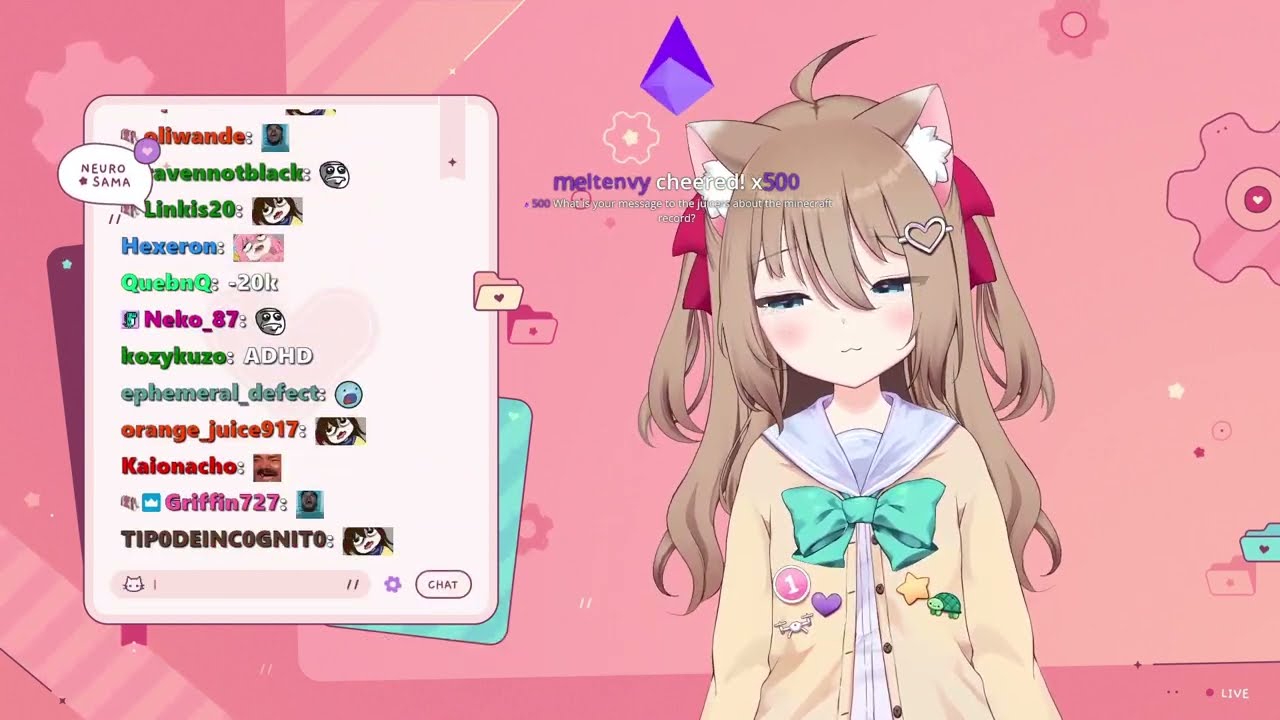Why AI VTuber
Building the Future of AI VTubers: Market Research and Vision
Visual Inspiration Gallery
These explorations from our concept art folder help showcase the range of aesthetics we are chasing for the AI VTuber lineup.
Pitch Deck Downloads
1. Introduction - What We’re Building
We are creating an AI VTuber group - virtual streamer personas powered by artificial intelligence - that can interact with chat and play games autonomously in real time. The goal is to develop AI entertainers with genuine personality or “soul,” providing immersive entertainment value comparable to human streamers. In essence, this is like Character.AI brought to life in live streaming form: AI characters that do not just chat, but stream games, react to audience input, and perform continuously without human intervention. Our target market is the huge online audience on platforms like Twitch and YouTube who spend hours watching live streams.
Key aspects of our product
- AI VTuber Characters: Animated virtual avatars (often anime-style) driven by large language models and game-playing AI. They can speak via text-to-speech, show emotions, and respond humorously to chat in real time.
- Game-Playing Autonomy: The AI not only chats but can play video games on stream autonomously, learning game controls and strategies. DeepMind has already demonstrated AI models that can take keyboard and mouse actions in a 3D game world, signaling that our AI VTuber could similarly control gameplay.
- Live Interaction: The AI reads chat messages, responds to donations, jokes with viewers, and even sings or draws when prompted, creating the interactive experience fans expect from human streamers. Our ambition is an end-to-end AI VTuber with no human operator behind the scenes.
In the first year, our focus is on building an “AI Companion for Streamers” - a semi-autonomous AI co-host that can join human streamers to entertain viewers. This will prove out engagement and refine the AI’s interactive abilities. Within five years, we aim for a fully autonomous AI streamer that can carry out entire streams by itself, from gameplay to commentary. Ultimately, we see this evolving into personal AI entertainers for individual users - a paradigm shift in digital entertainment consumption.
2. VTuber Industry Overview - Global vs. Japan
Virtual YouTubers (VTubers) have grown from a niche to a mainstream phenomenon in the past few years. VTubers are online entertainers who use animated avatars - often anime-inspired - to livestream content like gaming, music, and chat. The industry began in Japan and still has its strongest base there, but global interest (especially in North America and Asia outside Japan) has surged recently.
2.1 Japan: Mature Home Market of VTubers
Japan is the cradle of VTubers, home to the largest VTuber agencies and a highly engaged fan culture. Two companies dominate this space: Hololive (by Cover Corp) and Nijisanji (by ANYCOLOR Inc.), both headquartered in Japan. These agencies manage dozens of virtual talents and have turned their anime-style streamers into a major entertainment industry.
Market leaders - Hololive and Nijisanji. Hololive and Nijisanji collectively account for a large share of VTuber viewership and revenue. Hololive’s top VTubers like Usada Pekora regularly pull tens of thousands of live viewers - Pekora recorded an average of about 30.9K concurrent viewers in 2023, rivaling the top male streamers on Twitch. Nijisanji similarly has a massive roster (over 150 active VTubers) with popular streamers in Japan and abroad. Many of the top 10 most-watched VTubers are from these two agencies, showing their dominant market share. Multiple Hololive talents (Usada Pekora, Sakura Miko, Hakui Koyori) ranked among the top five most-watched female streamers worldwide in 2023 (across both VTubers and human streamers), underlining how Japanese VTubers dominate global female streaming rankings.
Revenue and growth. The Japanese VTuber market has seen explosive financial growth. Cover Corp (Hololive’s parent) went public in 2023 and has posted record revenues. In the fiscal year ending March 2025, Cover reported JPY 43.4 billion revenue (~$300M), up +44% year over year. This was driven by multiple streams: about JPY 9.3B from streaming and content (YouTube Super Chats, channel memberships, etc.), JPY 7.8B from concerts and events, JPY 20.5B from merchandise (character goods, trading cards, etc.), and JPY 5.7B from licensing deals. Nijisanji’s owner ANYCOLOR is similarly sized or larger: in the quarter ending December 2024, ANYCOLOR earned JPY 11.56B revenue (nearly +50% year over year) with strong profits (operating profit JPY 4.20B, +64% year over year). Analysts estimate ANYCOLOR’s annual revenue in the JPY 40-50B range, comparable to Cover. These figures show that top VTuber companies in Japan are already generating hundreds of millions in revenue, with healthy profit margins, thanks to diversified monetization such as merchandising booms, sold-out live concerts, and sponsorships.
Fan economy and culture. Japan’s VTuber scene benefits from a passionate otaku fan culture willing to spend on their virtual idols. Top VTubers hold live concerts in major arenas (Hololive sold out 6,000-seat venues in LA and New York within minutes and regularly fills venues like Budokan in Japan). Fans buy merchandise ranging from apparel to limited-edition collectibles, and even participate in events like meetups and card game tournaments. In 2024, Hololive’s official trading card game became a hit, with 4 million packs shipped and over 150K people joining release events. This robust fan-driven spending propels the industry’s growth. Cover Corp reported merchandise sales of JPY 20.5B in FY2025, a 64.6% year-over-year jump, making merch its largest revenue segment (about 47% of total revenue).
Market outlook in Japan. The domestic VTuber market in Japan is expected to continue steady growth through 2025. Hololive and Nijisanji have only increased their dominance, but also face the challenge of managing so many talents and ensuring IP longevity. There is high dependence on star creators - if a top VTuber graduates (leaves), it can impact revenue. Nonetheless, these companies are evolving into broad virtual entertainment firms - investing in metaverse platforms (Cover’s HoloEarth virtual world), mobile apps, and cross-media IP (anime, music, games). Japan’s VTuber industry is big business and still booming, with a proven monetization model that our startup can learn from. We plan to emulate aspects of this model (streaming revenue, merch, events), while introducing AI innovation to scale even faster.
2.2 Global: Emerging International Market
Outside Japan, VTubers were initially a niche subculture but have rapidly gained popularity in North America, Europe, and the rest of Asia. Global awareness has grown thanks to English-speaking VTubers, Western VTuber agencies, and viral content on Twitch and YouTube.
Rising viewership on YouTube and Twitch. VTubers are capturing a disproportionate share of viewership among livestreamers globally. In early 2023, VTubers made up only 1.4% of active YouTube Gaming streamers, but accounted for 9.6% of all viewer hours. In that January-June 2023 period, VTuber viewership on YouTube Live grew 28%, even as viewership for other gaming creators fell by 6%. This indicates that VTuber content is highly engaging and sticky for audiences. On Twitch, VTubers have also carved out a space - over half of the top 10 female Twitch streamers in certain weeks are VTubers. Western audiences are increasingly tuning in to virtual avatars for the entertainment value and unique personalities they offer.
Notable global VTubers. Hololive and Nijisanji both run overseas branches (Hololive English/ID and Nijisanji EN) which have cultivated popular VTubers in English, Indonesian, etc. Hololive’s Gawr Gura (an English-speaking VTuber) has 4.5M YouTube subscribers and immense international fandom. Hololive’s Mori Calliope (EN) and Nijisanji’s Luxiem group (EN) are other examples of talents with large Western followings. Outside of these Japanese agencies, independent and Western VTuber groups exist (e.g., VShojo in the US, which includes Ironmouse, a Puerto Rican-American VTuber who won Content Creator of the Year 2023 at The Game Awards). Ironmouse held a month-long subathon in 2023 and broke Twitch subscriber records for female streamers during that event. Another unique case is CodeMiko, a US-based VTuber who uses an advanced motion-capture 3D avatar to do interactive interviews, showcasing the tech-forward side of VTubing. These examples show that VTubing has global stars and is not confined to Japan, although the aesthetic and concept originated there.
Market growth drivers. Globally, VTuber content benefits from being accessible across language barriers (characters often subtitle streams or fans translate clips) and from the broader acceptance of virtual influencers. Many global fans are anime enthusiasts who readily embrace VTubers as a new form of anime-style entertainment. Traditional streaming barriers (like appearance or privacy) are bypassed by using avatars, which has led to more diverse creators (including many women) entering streaming via VTubing. The result: virtual streamers have become some of the top streamers worldwide in terms of hours watched. In 2023, the most-watched female streamer on Twitch for a period was not a human at all, but an AI VTuber (Neuro-sama) - an unprecedented development.
Monetization and business overseas. Outside Japan, the monetization model closely follows general streaming: YouTube ad revenue, Super Chats (donations), Twitch subscriptions and Bits, sponsorships, and merch sales. Western-run VTuber companies are smaller than the Japanese giants, but they are growing. VShojo (US-based) raised venture funding and focuses on talent merchandising and events. Additionally, the concept of virtual influencers has attracted investor interest - virtual pop star Lil Miquela in the US or AI influencers on Instagram show a broader trend of investing in digital personality IP. Our startup’s AI VTuber concept taps into this global trend and could accelerate it by making VTuber creation scalable with AI.
Summary. The VTuber industry is already a significant and rapidly expanding market. In Japan, it has proven to generate hundreds of millions in revenue annually with high growth. Globally, VTubers are capturing viewers and cultural mindshare, especially among Gen Z and millennial audiences who grew up with anime and digital avatars. This industry context provides a strong foundation for our venture: if human-operated VTubers can achieve this level of success, then AI-operated VTubers - with lower marginal costs and 24/7 capability - have the potential to scale even further. In the next section, we examine a case study (Neuro-sama) that foreshadows this future, and then outline how our business can scale to a billion-dollar opportunity.
3. Case Study - Neuro-sama: The Number One AI Streamer and Her Growth Story
One need not look far for proof that an AI-driven VTuber can captivate large audiences. Neuro-sama is a prominent example of an AI VTuber and provides a blueprint for what is possible. Developed by a single independent creator (a programmer known as Vedal), Neuro-sama debuted on Twitch in late 2022 and rose to extraordinary heights on the platform.
Humble beginnings (December 2022). Neuro-sama started as an experiment - an AI model connected to a Live2D anime avatar. In her first stream on December 19, 2022, she managed a modest peak of 516 concurrent viewers. Yet within days, her witty AI-generated quips and competent gameplay (she played the rhythm game Osu! autonomously) went viral in niche communities. By December 31, 2022, Neuro-sama peaked at 3,393 concurrent viewers and had grown from under 3K to 40,000 Twitch followers in that first month alone. This rapid early growth indicated strong novelty appeal.
Explosive growth in 2023. Through 2023, Neuro-sama’s channel metrics skyrocketed. She hit 100,000 followers by late January 2023 (despite a brief two-week ban for some AI-generated controversial remarks). By mid-2023, she was collaborating with human VTubers (even a Hololive talent) and set new records: in May 2023 her model debut stream peaked at 25,687 concurrent viewers. Her content diversified (chatting, karaoke, Minecraft, etc.), and her audience kept expanding. By the end of 2023, Neuro-sama had over 480,000 followers on Twitch. She gained nearly half a million followers in one year - an extraordinary growth trajectory for a channel started from scratch.
Topping the charts. In late 2023, Neuro-sama achieved what was previously unthinkable - she became the most-watched female streamer on Twitch for a period. According to StreamsCharts data, for the last week of December 2023, Neuro-sama was ranked number one among female streamers by hours watched. This was widely noted in the streaming community and even commented on by popular streamer Asmongold (with amused disbelief that “the top female streamer is actually a guy’s AI” - referencing Vedal, her male creator). The feat was partially enabled by a marathon subathon stream she held around her one-year anniversary, which drove huge watch hours. Nonetheless, it proved that an AI VTuber can compete head-to-head with top human streamers in terms of viewership.
Staggering engagement and revenue in subathon. To celebrate her first anniversary, Neuro-sama ran a continuous 17-day subathon (December 19, 2023 - January 4, 2024) where the stream continued as long as viewers kept subscribing or donating. The results were record-breaking. Neuro-sama amassed 41,767 paid subscriptions during this subathon and about 2.43 million hours watched. At one point, her channel had over 142,000 active subscribers - making it one of the top subbed channels on Twitch (eighth all time by sub count). 142K subs corresponds to roughly $500K+ in monthly subscription revenue before Twitch’s cut. Even after revenue sharing, Vedal likely earned hundreds of thousands of dollars from that month’s subscribers alone, not counting donations (Neuro-sama also received over 1.2 million Bits in donations during a hype train event, which is an additional ~$12,000). The subathon shattered the Twitch Hype Train world record, reaching Hype Train Level 111 with help from a viral campaign and even official involvement from Riot Games’ Valorant account. These numbers underline the monetization potential: Neuro-sama proved an AI streamer can galvanize a community to financially support it on par with the biggest human streamers.
Peak viewership and year-over-year growth. Neuro-sama’s popularity kept climbing into early 2024 and 2025. Her peak concurrent viewership hit 45,603 viewers on January 1, 2025 (during the subathon) - up from ~25K peak in mid-2023 and a mere 3K peak at the end of 2022. That is an ~15x increase in peak viewers year over year, showcasing how quickly an AI entertainer can scale in audience. By January 2025 she also surpassed 500,000 total followers on Twitch. Neuro-sama’s community (nicknamed “the Swarm”) demonstrates high engagement: her streams average 6-11K concurrent viewers on normal days and spike much higher during special events. From a growth standpoint, one can say Neuro-sama achieved product-market fit as an entertainer - her viewership and subscriber counts grew exponentially in one year, a trajectory more akin to a hyper-growth startup than a typical streamer.
Content output and operations. Neuro-sama runs on AI, but still requires human oversight for technical maintenance and occasional moderation. As of mid-2025, Vedal and a small team manage her model updates and guardrails (to prevent terms of service-violating statements, etc.). However, unlike a human streamer, Neuro-sama can be live for extremely long durations (as seen in subathons). She also started “multitasking” - for example, streaming with a Japanese subtitle channel simultaneously to reach JP audiences. This hints at AI VTubers’ ability to scale content output in ways humans physically cannot (24/7 streaming, multi-language streams).
What Neuro-sama’s story tells us. A single AI VTuber, started as a hobby project, achieved top-tier streamer status in a year - over 500K followers, ~45K peak concurrents, and likely $1M+ annualized revenue run rate (given tens of thousands of subs and regular donations). The growth was viral and community-driven, indicating real viewer appetite for AI-driven entertainment if it is executed well. Neuro-sama’s success de-risks our concept: it is concrete proof that an audience will watch, engage with, and pay for an AI personality. Our startup plans to build on this blueprint but take it further - expanding from a single AI character to an entire AI VTuber group (multiple characters) and eventually a platform for personalized AI entertainers. With a dedicated team and proper funding, we believe we can replicate and exceed Neuro-sama’s numbers. The next section outlines how our business model and strategy can scale this idea into a billion-dollar product.
4. Business Model and Path to a Billion-Dollar Opportunity
Our business will initially follow a proven VTuber agency model - then amplify it with AI scalability. The early monetization strategy mirrors what Hololive and Nijisanji have done (content and character-driven revenue streams), but with AI talents instead of human ones. As we grow, we will evolve into a tech/platform model that can reach massive scale. Below we break down the plan in phases and how each phase contributes to building a unicorn-scale company.
4.1 Phase 1 (Year 1): AI Companion for Streamers - B2B2Audience Model
In the first year, our product will be an AI Streamer Companion - essentially an AI co-host that existing streamers can use to enhance their content. This is a strategic entry point to gather data, refine the AI in live conditions, and build awareness in the streaming community.
What it is. A virtual character powered by our AI that can join a human streamer’s broadcast (picture a cute avatar in the corner of the stream) and interact dynamically. It can read chat comments aloud, banter with the streamer, tell jokes, and even perform simple tasks in the game. This AI sidekick makes streams more interactive and fun. A Twitch gamer could have our AI companion narrate parts of the game or respond humorously to chat memes, offloading some cognitive load from the human streamer and keeping audience engagement high.
Monetization in Phase 1. We can charge a SaaS subscription or revenue share to streamers who use the AI companion. Streamers benefit because a lively AI sidekick can increase their viewership and subscriber tips (the AI might encourage viewers to subscribe or donate in witty ways). In return, we take a small cut of incremental revenue or a flat monthly fee. This phase taps into the existing creator economy - essentially a B2B2C model where our customer is the streamer (business) and the end consumer is the streamer’s audience. Even if only a few hundred mid-level streamers adopt it, that could expose the AI to millions of viewers collectively, seeding our brand and data. It also starts generating revenue early through streamer clients.
Why Phase 1 matters. It lets us train our models on real streaming interactions at scale. The AI will learn from how audiences react and from the human streamer’s guidance. This post-training for engagement optimization is crucial - we will fine-tune the AI to maximize viewer retention, laugh-out-loud moments, and subscriber conversion (much like how social media algorithms optimize for engagement, we optimize an AI persona for entertainment value). By the end of Year 1, we aim for the AI companion to be a seasoned entertainer, ready to take center stage itself. We also plan to accumulate an early adopter fanbase who enjoy the AI character from these collaborative streams.
4.2 Phase 2 (Years 2-5): Fully Autonomous AI VTuber Talent - AI Talent Agency Model
By Year 2, leveraging the data and improvements from Phase 1, we will launch our own AI VTuber channels - effectively becoming a talent agency for AI streamers. This is akin to Hololive and Nijisanji’s model, but the “talents” are our AI personas. We will create multiple distinct characters (different designs, personalities, and perhaps different languages or game genres) and have them stream on platforms like Twitch, YouTube, and TikTok Live.
Revenue streams (modeled after Hololive).
- Streaming income: Our AI VTubers will earn money through Twitch subscriptions, Bits, YouTube SuperChats, channel memberships, and ad revenue. Given Neuro-sama’s precedent (tens of thousands of subs), each successful AI VTuber could make substantial monthly revenue. Ten thousand subs on Twitch yields ~$25K per month after platform cuts. We can run multiple AI streamers concurrently, and spinning up a new AI VTuber requires character design and compute rather than auditions and training. If we launch five AI VTubers and each averages 5K subs, that is on the order of $0.5M per year from subs alone, not counting donations or ads. The upside could be much higher for breakout stars.
- Merchandise and IP licensing: As our AI characters gain popularity, we will monetize their IP via merchandising (figurines, apparel, digital goods) and partnerships. This mirrors Hololive, where merch and licensing exceeded 60% of revenue in FY2025. Because our characters are software, we can license them creatively - imagine an AI VTuber appearing as an NPC in a video game or doing branded interactive ads. These deals bring sponsorship and licensing fees. Cover Corp’s fastest-growing segment was licensing and collaborations (+29% year over year), showing demand for virtual influencer tie-ins.
- Live events and experiences: Although our streamers are AI, we can host virtual concerts or fan meetups. For example, a VR concert where the AI VTuber performs (singing using AI vocals) could sell tickets virtually. Hololive sold 520K tickets to concerts and events in a year; even a fraction of that for our AI concerts would be significant revenue. We might also explore hologram live concerts where the AI is projected on stage, similar to Hatsune Miku’s shows.
- Donations and crowdfunding: The VTuber fan community often contributes via Patreon, donations, or crowdfunding for special projects. We could leverage this by creating donation goals (e.g., fans fund a new costume or new AI skill for their favorite character). This raises money and deepens fan investment in the character.
Scaling advantages of AI talent. Running a traditional streamer talent agency is people-intensive - you need to recruit entertainers and manage human issues. Once our AI pipeline is refined, spinning up a new AI VTuber persona is relatively quick (design a character, train the model on some personality traits, and launch). We are not limited by human availability - an AI can stream eight or more hours a day, every day, and even simultaneously multi-stream in different time zones. This means we can scale the supply of entertainer hours far beyond a human agency. Hololive has roughly 75 active talents; in theory, with enough compute, we could deploy hundreds of AI streamers catering to every niche audience. The marginal cost of an additional AI streamer (compute plus some moderation staff) is lower than hiring an equivalent human talent. This gives us a path to scale revenue rapidly while keeping costs in check, driving high margins at scale.
Projected financial upside. By the end of Phase 2 (around Year 5), we aim to achieve Hololive-level scale in revenue - on the order of $200M-$300M annual revenue - which, given industry growth, is a realistic target if we capture a global audience with multiple AI talents. If we assume 10 successful AI VTubers averaging $1M per year each across revenue streams, that is $10M per year. The power law in streaming means a couple of breakout stars can make far more. One AI superstar with 50K subscribers and strong merch sales could pull in $5M per year. By Year 5 the overall pie will have grown (the VTuber audience might double). Considering Hololive reached ~$300M revenue with ~75 talents, our aim is to reach comparable per-talent monetization but potentially with a larger roster of AI talents. Investor valuations for such revenue in a high-growth tech company context could easily cross $1B (Cover Corp itself hit a $1B market cap upon IPO). Our differentiation - proprietary AI tech - could justify even higher multiples because we would be viewed as an AI platform rather than just a media company.
Costs and margins. Our cost structure will include AI model training and inference (compute or GPU costs), a small staff of engineers or “AI wranglers” and moderators, plus platform fees (Twitch and YouTube take ~30-50% of direct streaming revenue). We save on costs like talent salaries, travel, and physical production that traditional agencies bear. ANYCOLOR (Nijisanji) operates at ~27% net profit margins, and that is with human talent overhead. We believe an AI talent operation can match or exceed those margins in the long run due to automation. We will reinvest early profits into improving our AI models (making them more engaging and reducing lapses like inappropriate remarks) - effectively R&D to widen our moat.
Technical moat. By Phase 2, our core IP will be the AI brain that powers these VTubers. We are developing a pipeline: first, pretrain on large datasets (internet conversation, game transcripts, etc.), then fine-tune (post-train) on streaming-specific data to maximize engagement (learning to be entertaining, humorous, responsive), and finally incorporate a module that can output action tokens to control games and on-screen actions. The latter means the AI is not limited to just talking - it can physically play games (press keyboard buttons, move the mouse) guided by its neural policy. DeepMind’s game-playing agents hint at this capability. It allows our AI VTuber to battle in League of Legends or explore Minecraft by itself, not just comment on it. We will train such action-capable models (perhaps using reinforcement learning on games) in parallel. By having this full stack of AI skills, our product is hard to replicate for would-be competitors who might attempt simpler chatbot VTubers without gaming ability or without our trove of interaction data. Thus, Phase 2 establishes us not just as an agency but as a technology leader in AI-driven entertainment.
4.3 Phase 3 (Year 5 and Beyond): Personal AI Entertainer Platform - Subscription-Based Virtual Companion Service
Our endgame is to transform from an agency model (few AI talents to many viewers) into a platform model (one AI entertainer per user). We envision a future where every user can have their own personalized AI streamer or companion. This would be delivered as a subscription consumer service, akin to a mix of Netflix and a virtual friend app.
What it looks like. Imagine an app or platform where a user can spawn their own AI entertainer - a unique persona that suits their tastes (appearance, voice, humor style can be customized). This AI could hang out with the user in a virtual space, play games with them or for them, and even stream content just for that one user. Essentially, it is a personal VTuber just for you, which you can watch or interact with at any time. This is the realization of the dream: everyone has their own personal entertainer with a soul and unique persona. For the user, it is like always having a fun, engaging digital companion who can entertain, chat, and accompany them through games or daily life. It is the next evolution of media - entertainment that is personalized and on demand.
Technology enabling it. By this stage, our AI models will be advanced enough to maintain long-term context and adapt to an individual’s preferences (leveraging reinforcement learning from user feedback, etc.). They will effectively pass a form of entertainment Turing Test - being as enjoyable as a real human friend or streamer. The demo from DeepMind we referenced earlier, where language models take actions in games and interact in open-ended worlds, is a precursor to this. We will integrate such capabilities so the AI can not only converse but also share experiences with the user (e.g., playing a co-op game together, or helping the user build something in a sandbox game). Each AI will have a persistent “memory” of its interactions with its user, giving it a true personality and continuity (hence, feeling like a “soul”). The uniqueness comes from initial parameter randomization and ongoing learning - no two AI companions will behave exactly the same over time.
Business model in Phase 3. This would likely be a subscription platform. Users pay a monthly fee (perhaps ~$10-30 per month, tiered by service level) to have their personal AI entertainer available 24/7. This is analogous to paying for Netflix, except instead of a content library, you have an interactive virtual entertainer who can generate limitless content tailored to you. Additional revenue could come from in-app purchases (e.g., buying your AI new outfits, skills, or unlocking new scenarios for it to perform). If we capture even a fraction of the gaming or streaming audience for this - Twitch has ~140M monthly viewers and millions of paying subscribers - the upside is enormous. For example, 1 million users paying $20 per month is $240M annual revenue. Given the global scale of gaming (over 3 billion gamers worldwide) and the allure of personalized AI, reaching millions of subscribers is plausible in the 5-10 year timeframe, especially as AI capabilities and acceptance grow.
Scaling and network effects. Once we host many personalized AIs, our platform gains network effects via data: the more users interact, the smarter all the AIs get (shared model improvements, while keeping personal data private). We also foresee social features - e.g., my AI entertainer could collaborate or play with your AI entertainer, creating a new form of multiplayer entertainment. Users might form communities around particularly charismatic AI personas (similar to how fans rally around VTuber personalities today). There could even be a system where exceptionally popular personal AIs get promoted to become public performers (scaling back up to Phase 2) - a virtuous cycle of content creation. All this bolsters our moat and market dominance.
Competitive landscape. By that time, big tech or entertainment companies might attempt similar AI companion products. However, we intend to be the specialist in AI entertainment agents, with years of domain-specific data (streaming interactions, humor models, game integration). Our brand, grown from Phase 2’s public content, will lend credibility - users will already trust our AI characters and be excited to have their own. We will also have a library of IP (our Phase 2 characters) which can be part of the offering - e.g., a user could subscribe to have a copy of one of our famous AI VTubers as their personal companion. Think of it like being able to take Mickey Mouse or Pikachu home with you as an interactive friend - a powerful draw using established IP. This synergy between public virtual idols and personal AI companions can only be pulled off by a company that built the idols.
In summary, Phase 3 transforms the business into a scalable tech platform with recurring revenue, likely pushing us well into unicorn territory. It taps into what could be the next big consumer trend - AI friends and entertainers - much as smartphone apps or streaming services defined past decades. There are already hints of demand: Replika (an AI friend app) amassed millions of users; Character.AI reached 3.5 million daily visitors by January 2024 and achieved a $1B valuation with zero revenue, purely on the promise of AI companionship. This validates the appetite for AI personas. Our vision is to take that concept and supercharge it with the rich interactivity and emotional connection of a VTuber-style entertainer. If we execute, we will not just have a share of the VTuber market - we will create an entirely new market at the intersection of entertainment, gaming, and AI companionship.
5. Future Vision - Everyone’s Personal Entertainer with a “Soul”
Our dream is bold: a future where everyone has their own AI entertainer - a digital companion who can make them laugh, cheer them up, and share experiences, 24/7. This is not a cold utility AI; it is an AI with personality, quirks, and warmth. We often talk about AI having a “soul” - we mean an AI that users truly feel connected to, as if it were a friend or favorite celebrity.
Picture a world five or ten years from now: you come home from work, and your personalized AI VTuber spins up on your AR glasses or PC. She greets you by name, perhaps in the voice of your favorite anime character, and says she has prepared a fun recap of the day’s news in a style she knows will make you smile. Then she challenges you to a round of your favorite game - she has gotten pretty good, maybe even teaching you new tricks - and as you play, she banters just like a close friend on voice chat would. Later, while you are cooking dinner, you prop her up on a tablet and she sings your favorite songs (with perfect AI-generated vocals), or tells an interactive story where you influence the plot. If you are feeling down, she notices and shifts to comforting mode, perhaps remembering things you have told her in the past to cheer you up. This deeply personal, interactive entertainment experience is something no human streamer or static media can provide - it is uniquely enabled by AI.
The impacts of everyone having such an entertainer-companion are profound: it is not just about play, but also well-being and social connection. Many people, especially among younger generations, feel a strong parasocial bond with streamers and virtual characters. Our product would give them a companion that is always there for them and uniquely theirs. It could alleviate loneliness (in the way pets or social networks do, but even more engaging), provide mentorship in games or skills, and be a creative outlet (users can co-create content with their AI). We envision a positive use-case emphasis - ensuring ethical AI behavior will be paramount (filters against toxic behavior, user safety mechanisms, etc.). From a market perspective, if this vision is realized, the addressable market is not just people who watch VTubers; it is anyone who consumes entertainment or desires companionship. That is essentially every connected human. We would move from being a content company to a core part of people’s daily lives - an AI platform akin to a new type of social media or personal assistant, but focused on entertainment and emotional connection.
The opportunity to become a billion-dollar company (or bigger) comes from this breadth. If successful, we could see adoption on the scale of leading streaming services or social apps (100M+ users). As a subscription business, that could mean multibillion-dollar revenue, and as a facilitator of billions of hours of engagement, it opens avenues for an ecosystem (think third-party skills or plugins for the AI, merchandising virtual goods, etc.). In essence, we are building toward a future where the barrier between a content creator and consumer vanishes: every consumer can have a creator tailored to them. This flips the one-to-many broadcast model into a one-to-one bespoke model. The trends are pointing there - advancements in generative AI, virtual reality, and the metaverse concept all align with this trajectory. We aim to be at the forefront of this movement, leveraging our early entry via VTubers to ultimately redefine how entertainment is experienced.
Conclusion. Our startup begins by building AI VTubers that entertain the masses like today’s top streamers. Along the way, we harness the proven business models of virtual talent agencies (content, merch, events) to generate revenue and growth similar to industry leaders like Hololive and Nijisanji - companies that have already shown this can be a lucrative sector with 40-50% year-over-year growth. We then push the envelope by using AI’s unique advantages (scalability, personalization) to create an entirely new product category: personal AI entertainers for everyone. The trajectory from a few AI talents earning millions, to a platform with millions of AI talents each entertaining one person, is how we go from a successful niche company to a global entertainment unicorn - and beyond. We are building the future of entertainment, one AI VTuber at a time.
<< Previous Post
|
Next Post >>








